Related Research Articles
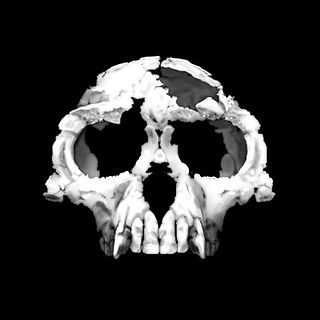
Ardipithecus is a genus of an extinct hominine that lived during the Late Miocene and Early Pliocene epochs in the Afar Depression, Ethiopia. Originally described as one of the earliest ancestors of humans after they diverged from the chimpanzees, the relation of this genus to human ancestors and whether it is a hominin is now a matter of debate. Two fossil species are described in the literature: A. ramidus, which lived about 4.4 million years ago during the early Pliocene, and A. kadabba, dated to approximately 5.6 million years ago. Initial behavioral analysis indicated that Ardipithecus could be very similar to chimpanzees, however more recent analysis based on canine size and lack of canine sexual dimorphism indicates that Ardipithecus was characterised by reduced aggression, and that they more closely resemble bonobos.

The chimpanzee, or simply known as the chimp, is a species of great ape native to the forests and savannahs of tropical Africa. It has four confirmed subspecies and a fifth proposed one. When its close relative the bonobo was more commonly known as the pygmy chimpanzee, this species was often called the common chimpanzee or the robust chimpanzee. The chimpanzee and the bonobo are the only species in the genus Pan. Evidence from fossils and DNA sequencing shows that Pan is a sister taxon to the human lineage and is thus humans' closest living relative. The chimpanzee is covered in coarse black hair, but has a bare face, fingers, toes, palms of the hands, and soles of the feet. It is larger and more robust than the bonobo, weighing 40–70 kg (88–154 lb) for males and 27–50 kg (60–110 lb) for females and standing 150 cm.
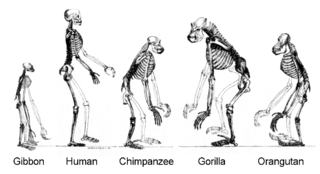
Human evolution is the evolutionary process within the history of primates that led to the emergence of Homo sapiens as a distinct species of the hominid family that includes all the great apes. This process involved the gradual development of traits such as human bipedalism, dexterity, and complex language, as well as interbreeding with other hominins, indicating that human evolution was not linear but weblike. The study of the origins of humans, also called anthropogeny, anthropogenesis, or anthropogony, involves several scientific disciplines, including physical and evolutionary anthropology, paleontology, and genetics.

Homininae, also called "African hominids" or "African apes", is a subfamily of Hominidae. It includes two tribes, with their extant as well as extinct species: 1) the tribe Hominini ―and 2) the tribe Gorillini (gorillas). Alternatively, the genus Pan is sometimes considered to belong to its own third tribe, Panini. Homininae comprises all hominids that arose after orangutans split from the line of great apes. The Homininae cladogram has three main branches, which lead to gorillas, and to humans and chimpanzees via the tribe Hominini and subtribes Hominina and Panina. There are two living species of Panina and two living species of gorillas, but only one extant human species. Traces of extinct Homo species, including Homo floresiensis have been found with dates as recent as 40,000 years ago. Organisms in this subfamily are described as hominine or hominines.

The Paleolithic or Palaeolithic, also called the Old Stone Age, is a period in human prehistory that is distinguished by the original development of stone tools, and which represents almost the entire period of human prehistoric technology. It extends from the earliest known use of stone tools by hominins, c. 3.3 million years ago, to the end of the Pleistocene, c. 11,650 cal BP.

Dame Jane Morris Goodall, formerly Baroness Jane van Lawick-Goodall, is an English primatologist and anthropologist. She is considered the world's foremost expert on chimpanzees, after 60 years' studying the social and family interactions of wild chimpanzees. Goodall first went to Gombe Stream National Park in Tanzania to observe its chimpanzees in 1960.

The genus Pan consists of two extant species: the chimpanzee and the bonobo. Taxonomically, these two ape species are collectively termed panins. The two species were formerly collectively called "chimpanzees" or "chimps"; if bonobos were recognized as a separate group at all, they were referred to as "pygmy" or "gracile chimpanzees". Together with humans, gorillas, and orangutans they are part of the family Hominidae. Native to sub-Saharan Africa, chimpanzees and bonobos are currently both found in the Congo jungle, while only the chimpanzee is also found further north in West Africa. Both species are listed as endangered on the IUCN Red List of Threatened Species, and in 2017 the Convention on Migratory Species selected the chimpanzee for special protection.

Behavioral modernity is a suite of behavioral and cognitive traits that distinguishes current Homo sapiens from other anatomically modern humans, hominins, and primates. Most scholars agree that modern human behavior can be characterized by abstract thinking, planning depth, symbolic behavior, music and dance, exploitation of large game, and blade technology, among others. Underlying these behaviors and technological innovations are cognitive and cultural foundations that have been documented experimentally and ethnographically by evolutionary and cultural anthropologists. These human universal patterns include cumulative cultural adaptation, social norms, language, and extensive help and cooperation beyond close kin.

The Hominini form a taxonomic tribe of the subfamily Homininae ("hominines"). Hominini includes the extant genera Homo (humans) and Pan and in standard usage excludes the genus Gorilla (gorillas).
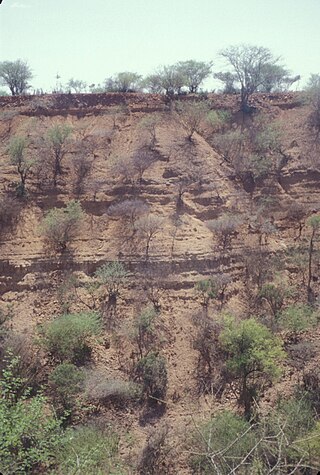
The Kapthurin Formation is a series of Middle Pleistocene sediments associated with the East African Rift Valley. Part of the East African Rift System, it is also an important archaeological site in the study of early humans who occupied the area and left stone tools and animal bones behind. It outcrops in Kenya west of Lake Bogoria and northwest of Lake Baringo in the Kenya Rift Valley, exposed on the surface in a 150 km2 (58 sq mi) area. It also outcrops in portions of the Tugen Hills farther east. The ~125 metres (410 ft) of sediment that comprises the Kapthurin formation represents more than 600,000 years of depositional history. Clastic sediments, tuffs, and carbonate beds, in the Kapthurin give information on past river and lake environments. Additionally, intercalated tuffs and extrusive igneous rocks associated with Rift Valley volcanic activity have allowed for multiple argon–argon dating studies. The high resolution dating enables archaeological studies regarding changing hominin behavior. The Kapthurin Formation has been used to study the Acheulian-Middle Stone Age transition.
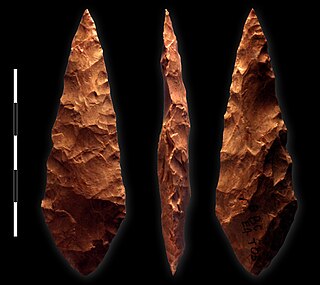
The Middle Stone Age was a period of African prehistory between the Early Stone Age and the Late Stone Age. It is generally considered to have begun around 280,000 years ago and ended around 50–25,000 years ago. The beginnings of particular MSA stone tools have their origins as far back as 550–500,000 years ago and as such some researchers consider this to be the beginnings of the MSA. The MSA is often mistakenly understood to be synonymous with the Middle Paleolithic of Europe, especially due to their roughly contemporaneous time span; however, the Middle Paleolithic of Europe represents an entirely different hominin population, Homo neanderthalensis, than the MSA of Africa, which did not have Neanderthal populations. Additionally, current archaeological research in Africa has yielded much evidence to suggest that modern human behavior and cognition was beginning to develop much earlier in Africa during the MSA than it was in Europe during the Middle Paleolithic. The MSA is associated with both anatomically modern humans as well as archaic Homo sapiens, sometimes referred to as Homo helmei. Early physical evidence comes from the Gademotta Formation in Ethiopia, the Kapthurin Formation in Kenya and Kathu Pan in South Africa.

Zeresenay "Zeray" Alemseged is an paleoanthropologist who is a faculty member at the University of Chicago. In 2013, he was named a Fellow of the American Association for the Advancement of Science. He was elected to the American Academy of Arts & Sciences in 2021. In 2022, he was appointed to the Comité Scientifique International du Musée d’Anthropologie Préhistorique de Monaco and the Pontifical Academy of Science. Alemseged is best known for his discovery, on 10 December 2000, of Selam, also referred to as the "Dikika child" or “Lucy’s child”, the almost-complete fossilized remains of a 3.3 million-year-old child of the species Australopithecus afarensis. The “world’s oldest child”, she is the most complete skeleton of a human ancestor discovered to date. Selam represents a milestone in understanding of human and pre-human evolution and contributes significantly to understanding of the biology and childhood of early species in the human lineage; a subject about which we have very little information. Alemseged discovered Selam while working with the Dikika Research Project (DRP), a multi-national research project funded in part by the National Science Foundation, which he both initiated in 1999 and leads. The DRP has thus far made many important paleoanthropological discoveries and returns to the field each year to conduct further important research. Alemseged's specific research centers on the discovery and interpretation of hominin fossil remains and their environments, with emphasis on fieldwork designed to acquire new data on early hominin skeletal biology, environmental context, and behavior.

Ardipithecus kadabba is the scientific classification given to fossil remains "known only from teeth and bits and pieces of skeletal bones", originally estimated to be 5.8 to 5.2 million years old, and later revised to 5.77 to 5.54 million years old. According to the first description, these fossils are close to the common ancestor of chimps and humans. Their development lines are estimated to have parted 6.5–5.5 million years ago. It has been described as a "probable chronospecies" of A. ramidus. Although originally considered a subspecies of A. ramidus, in 2004 anthropologists Yohannes Haile-Selassie, Gen Suwa, and Tim D. White published an article elevating A. kadabba to species level on the basis of newly discovered teeth from Ethiopia. These teeth show "primitive morphology and wear pattern" which demonstrate that A. kadabba is a distinct species from A. ramidus.
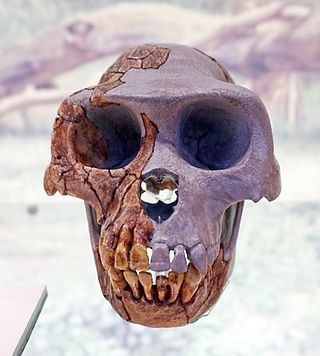
Ardipithecus ramidus is a species of australopithecine from the Afar region of Early Pliocene Ethiopia 4.4 million years ago (mya). A. ramidus, unlike modern hominids, has adaptations for both walking on two legs (bipedality) and life in the trees (arboreality). However, it would not have been as efficient at bipedality as humans, nor at arboreality as non-human great apes. Its discovery, along with Miocene apes, has reworked academic understanding of the chimpanzee–human last common ancestor from appearing much like modern-day chimpanzees, orangutans and gorillas to being a creature without a modern anatomical cognate.
The chimpanzee–human last common ancestor (CHLCA) is the last common ancestor shared by the extant Homo (human) and Pan genera of Hominini. Estimates of the divergence date vary widely from thirteen to five million years ago.

The Jane Goodall Institute Chimpanzee Eden, commonly referred to as Chimp Eden, is situated within a 1,000 ha game reserve and animal sanctuary for rescued chimpanzees, in the Umhloti Nature Reserve, near Barberton, Mpumalanga, South Africa. Opened in 2006 by founder and director Eugene Cussons, in collaboration with the Jane Goodall Institute (JGI), its purpose is to provide a permanent and safe home for chimpanzees who are rescued from abusive and unfortunate circumstances from areas where these great apes are being constantly exploited by humans through the bushmeat trade, pet trade and entertainment industries. At the sanctuary, the chimpanzees are rehabilitated with the help of their care takers in being re-introduced back into chimpanzee social skills and live in a social group with others of their own kind.
Baringo District was an administrative district in the Rift Valley Province of Kenya. Its capital town was Kabarnet. The district had a population of 264,978 and an area of 8,646 km2 (3,338 sq mi). The district was created by the colonial government. In 2013, the district ceased to exist and Baringo County was formally established.

Nina G. Jablonski is an American anthropologist and palaeobiologist, known for her research into the evolution of skin color in humans. She is engaged in public education about human evolution, human diversity, and racism. In 2021, she was elected to the U.S. National Academy of Sciences and in 2009, she was elected to the American Philosophical Society. She is an Evan Pugh University Professor at The Pennsylvania State University, and the author of the books Skin: A Natural History, Living Color: The Biological and Social Meaning of Skin Color, and the co-author of Skin We Are In.

John Joseph Shea is an American archaeologist and paleoanthropologist. He has been a professor of anthropology at Stony Brook University in New York since 1992.
Alison S. Brooks is an American paleoanthropologist and archaeologist whose work focuses on the Paleolithic, particularly the Middle Stone Age of Africa. She is one of the most prominent figures in the debate over where Homo sapiens evolved and when.
References
- 1 2 3 "Sally McBrearty". Center for Academic Research and Training in Anthropogeny (CARTA). UC San Diego / Salk Institute for Biological Studies . Retrieved 26 June 2018.
- ↑ "Sally McBrearty – Curriculum Vitae" (PDF). University of Connecticut . Retrieved 26 June 2018.
- ↑ "AAAS Annual Report – 2007". American Association for the Advancement of Science. 31 December 2007. p. 22. Retrieved 26 June 2018.
- ↑ Wilford, John Noble (26 February 2002). "When Humans Became Human". The New York Times. Retrieved 28 June 2018.
- ↑ Tomlinson, Gary (9 May 2018). Culture and the Course of Human Evolution. University of Chicago Press. ISBN 9780226548661.
- 1 2 "First chimpanzee fossils found". BBC News. 31 August 2005. Retrieved 26 June 2018.
- 1 2 Hopkin, Michael (29 August 2005). "First chimp fossil unearthed". Nature News. doi:10.1038/news050829-10. ISSN 1744-7933.
- ↑ Orwant, Robert (31 August 2005). "First convincing chimp fossil discovered". New Scientist. Retrieved 26 June 2018.
- 1 2 "Making the paper: Sally McBrearty and Nina Jablonski". Nature. 437 (7055): xiii. 1 September 2005. doi: 10.1038/437xiiia . ISSN 0028-0836. S2CID 29485961.
- ↑ McBrearty, Sally; Jablonski, Nina G. (2005). "First fossil chimpanzee". Nature. 437 (7055): 105–108. Bibcode:2005Natur.437..105M. doi:10.1038/nature04008. ISSN 0028-0836. PMID 16136135. S2CID 4423286.
- ↑ Beech, Mark Jonathan (21 September 2015). "A renowned and admired palaeoanthropologist who devoted much time to Abu Dhabi's wilderness". The National. Retrieved 26 June 2018.
- ↑ Bishop, Laura; Fisher, Rebecca; Plummer, Tom; Rossie, James; Scott, Monique (25 September 2015). "Remembering Dr. Andrew Hill". Department of Anthropology News. Yale University . Retrieved 26 June 2018.